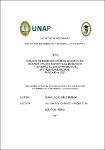| dc.contributor.advisor | Chávez Vásquez, Rafael | |
| dc.contributor.author | Díaz Burga, Juan Lucas | |
| dc.date.accessioned | 2018-03-16T15:12:59Z | |
| dc.date.available | 2018-03-16T15:12:59Z | |
| dc.date.issued | 2017 | |
| dc.identifier.uri | http://repositorio.unapiquitos.edu.pe/handle/20.500.12737/5304 | |
| dc.description.abstract | El trabajo se realizó en el Distrito Punchana; a fin de investigar cúales son los
impactos socio ambiental en el manejo de los residuos sólidos (Bazofias) de
ganado vacuno durante el beneficio Matadero Municipal; con 9,411 vacunos,
durante el año 2016. El método, es no experimental de tipo cuantitativo y
cualitativo, y el diseño descriptivo, transversal y correlacionar; teniendo como
resultados la cantidad total y destino final (Con manejo); Residuos semilíquidos
que se vierten al alcantarillado público 57,313 kg; aprovechamiento como abono
orgánico 334,091 kg., y los residuos inorgánicos 4,141 kg. que se arrojan a la
basura. Mediante la Matriz de leopold, se identificó que la playa de beneficio y
sala de menudencias, que es la actividad que genera mayor magnitud de impacto
negativo (-65). Se realizó tres encuestas de percepción: Sobre el manejo de
residuos en la sala de menudencias, resulto que el 86.67 por ciento contribuiría a que se
implemente un plan de manejo; Evaluación de impactos ambiental al exterior,
resulto que el 51.55 por ciento, indican que no existe impacto negativo, y Alternativas de
mitigación de impactos al interior del Matadero, resulto que el 98.52 por ciento
contribuiría a que se implente el Plan de manejo. Concluyendo que se generó
información relevante de tipo tecnológica; se identificó puntos críticos de
contaminación y su solución; se determinó la cantidad de residuos sólidos que se
generan durante el beneficio que es motivo de contaminación ambiental negativo
a la sociedad, al entorno y a los cuerpos de agua, suelo y aire. | es_PE |
| dc.description.abstract | The work was carried out in the Punchana District; in order to investigate the socio-environmental impacts in the management of solid waste (Bazofias) of cattle during the Municipal Slaughterhouse benefit; with 9,411 cattle, during the year 2016. The method is non-experimental of quantitative and qualitative type, and the descriptive, transverse and correlated design; resulting in the total amount and final destination (with management); Waste semiliquid’s that are discharged to the public sewage 57,313 kg; use as organic manure 334,091 kg., and inorganic waste 4,141 kg. which are voted in the trash. Through the Leopold Matrix, it was identified that the beach of benefit and gentry, is the activity that generates greater magnitude of negative impact (-65). Three perception surveys were carried out: On the waste management in the triage room, 86.67% resulted in the implementation of a management plan; Evaluation of environmental impacts to the outside, resulting in 51.55%, indicate that there is no negative impact, and Alternatives to mitigation of impacts to the interior of the Slaughterhouse, resulted that 98.52% would contribute to the implementation of the Management Plan. Concluding that relevant technological information was generated; critical pollution points and their solution were identified; was determined the amount of solid waste generated during the benefit that causes negative environmental pollution to society, the environment and bodies of water, soil and air. | en_US |
| dc.description.uri | Tesis | es_PE |
| dc.format | application/pdf | es_PE |
| dc.language.iso | spa | es_PE |
| dc.publisher | Universidad Nacional de la Amazonía Peruana | es_PE |
| dc.rights | info:eu-repo/semantics/restrictedAccess | es_PE |
| dc.rights.uri | http://creativecommons.org/licenses/by-nc-nd/3.0/us/ | * |
| dc.source | Universidad Nacional de la Amazonía Peruana | es_PE |
| dc.source | Repositorio institucional - UNAP | es_PE |
| dc.subject | Manejo de desechos | es_PE |
| dc.subject | Ganado | es_PE |
| dc.subject | Impacto ambiental | es_PE |
| dc.subject | Mataderos | es_PE |
| dc.title | Manejo de residuos sólidos (bazofia) de ganado vacuno durante el beneficio y su impacto socio-ambiental matadero municipal Punchana -2017 | es_PE |
| dc.type | info:eu-repo/semantics/doctoralThesis | es_PE |
| thesis.degree.discipline | Agronomía | es_PE |
| thesis.degree.grantor | Universidad Nacional de la Amazonía Peruana. Escuela de Posgrado | es_PE |
| thesis.degree.level | Doctorado | es_PE |
| thesis.degree.level | Doctorado | es_PE |
| thesis.degree.name | Doctor en Ambiente y Desarrollo Sostenible | es_PE |
| thesis.degree.program | Regular | es_PE |
| dc.subject.ocde | Agronomía | es_PE |
| dc.subject.ocde | http://purl.org/pe-repo/ocde/ford#4.01.06 | es_PE |



